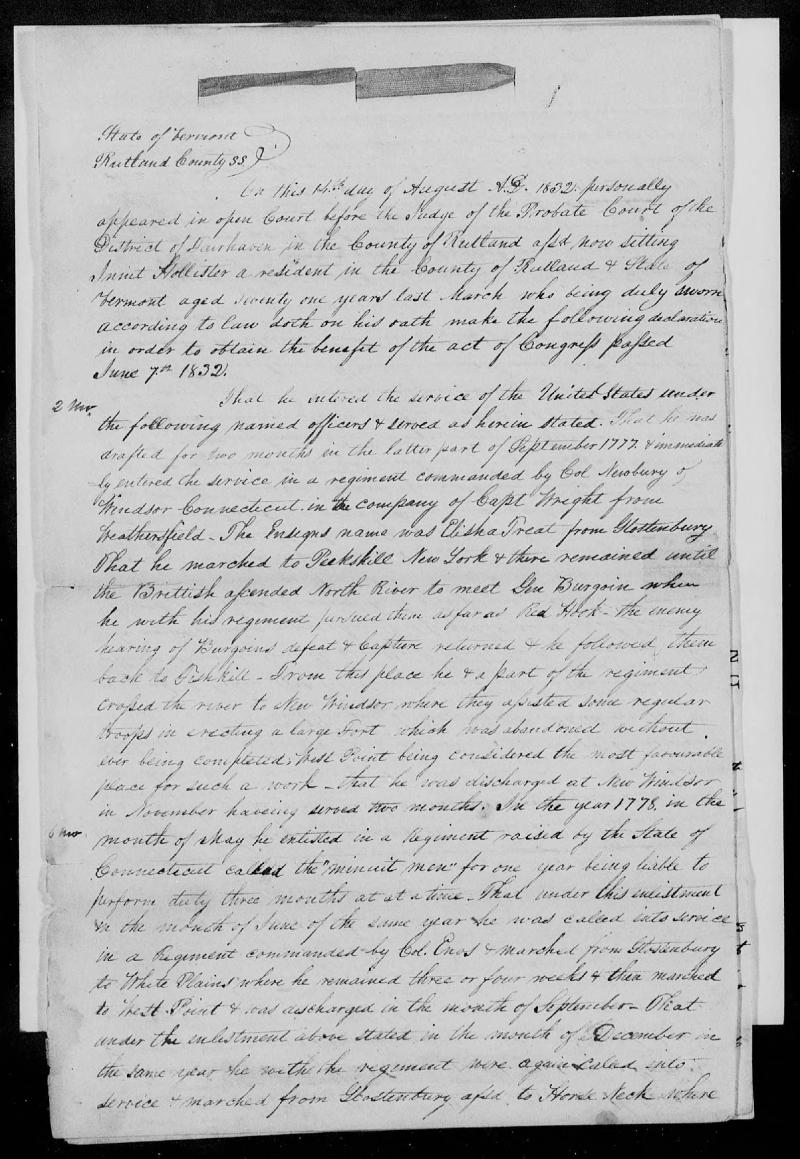The National Archives needs Citizen Archivists who can read cursive
By: Elizabeth Weise (USA TODAY)



The National Archives needs Citizen Archivists who can read cursive
The National Archives is looking for volunteers with an increasingly rare skill: Reading cursive.
Or a few million. More than 200 years worth of U.S. documents need transcribing (or at least classifying) and the vast majority from the Revolutionary War era are handwritten in cursive - requiring people who know the flowing, looped form of penmanship.
"Reading cursive is a superpower," said Suzanne Isaacs, a community manager with the National Archives Catalog in Washington, D.C.
She is part of the team that coordinates the more than 5,000 Citizen Archivists helping the Archive read and transcribe some of the more than 300 million digitized objects in its catalog. And they're looking for volunteers with an increasingly rare skill.
Those records range from Revolutionary War pension records to the field notes of Charles Mason of the Mason-Dixon Line to immigration documents from the 1890s to Japanese evacuation records to the 1950 Census.
"We create missions where we ask volunteers to help us transcribe or tag records in our catalog," Isaacs said.
To volunteer, all that's required is to sign up online and then launch in. "There's no application," she said. "You just pick a record that hasn't been done and read the instructions. It's easy to do for a half hour a day or a week."
Being able to read the longhand script is a huge help because so many of the documents are written using it.
"It's not just a matter of whether you learned cursive in school, it's how much you use cursive today," she said.
Cursive has fallen out of use
American's skill with this connected form of script has been slowly waning for decades.
Schoolchildren were once taught impeccable copperplate handwriting and penmanship was something they were graded on.
That began to change when typewriters first came into common use in the business world in the 1890s and was further supplanted in the 1980s by computers.
Still, handwriting continued to be considered a necessary skill until the 1990s when many people shifted to email and then in the 2000s to texting.
By 2010, the Common Core teaching standards emphasized keyboard skills (once taught as "typewriting") and no longer required handwriting on the presumption that most of the writing students would do would be on computers.
That led to a pushback and today at least 14 states require that cursive handwriting be taught, including California in 2023. But it doesn't mean that they actually use it in real life.
In the past, most American students began learning to write in cursive in third grade, making it a rite of passage, said Jaime Cantrell, a professor of English at Texas A&M University - Texarkana whose students take part in the Citizen Archivist work, putting their skills reading old documents to work.
For her generation, "cursive was a coming-of-age part of literacy in the 1980s. We learned cursive and then we could write like adults wrote," she said.
While many of her students today learned cursive in school, they never use it and seldom read it, she said. She can tell because she writes feedback on their papers in cursive.
Some of her students aren't even typing anymore. Instead, they're just using talk-to-text technology or even artificial intelligence. "I know that because there's no punctuation, it reads like a stream of consciousness."
It's an uphill - but by no means impossible - battle to become comfortable with reading and writing the conjoined script. And it opens up access to a wealth of older documents.
Cursive is still a skill for some
California passed a law in 2023 requiring that "cursive or joined italics" be taught for first through sixth grades. The law's author said it was so students could read primary source historical documents.
That's exactly how Cantrell's students use it. One of the classes she teaches involves deciphering documents written in the 18th and 19th centuries - and one of their projects is to get involved in the National Archive's transcription work.
"There is certainly a learning curve," said Cantrell. "But my students stick it out. They feel like they have a duty, they feel like they're making a difference."
Being able to read cursive is just the start of deciphering older documents, said the National Archive's Nancy Sullivan. The handwriting of the 18th and 19th centuries isn't what today's third graders are taught.
Though sometimes the oldest writing is the easiest to read, said Cantrell.
"If you look at Abigail Adams' letters to her husband (President John Adams) and his responses, the cursive is an art form, it's so uniform," she said.
AI can only go so far with cursive
AI is starting to be able to read cursive but only with human help, said the National Archive's Sullivan.
The Archives has been working with FamilySearch, a genealogical nonprofit operated by the Church of Jesus Christ of Latter-day Saints that offers free genealogical software, searching and access to historical documents.
FamilySearch developed an AI program that reads handwritten documents. However, a person is still required to do the final edit.
"There's usually some mistakes," she said. "So we call it 'extracted text' and our volunteers have to look it over and compare it to the original." Only once a volunteer has looked the document over is it considered an actual transcription.
And AI can't always decipher the often problematic documents their volunteers deal with, said Isaacs. Sometimes they've been torn, smudged, folded, or dog-eared. In the case of Revolutionary War pension applications, widows had to prove they were married so they often included handwritten family tree pages torn from the family Bible.
Not to mention simple poor penmanship. "Some of the Justices of the Peace, their handwriting is atrocious," said volunteer Christine Ritter, 70, who lives in Fairless Hills, Pennsylvania.
There are cross-outs, things written on the other side that bleed through, strange and inventive spellings, old forms of letters (a double S was sometimes written as a "long s" and looked like an F) and even children's doodles over top. And many obsolete terms and legal words that can flummox even the most erudite readers.
"It feels like solving a puzzle. I really enjoy it," said volunteer Tiffany Meeks, 37. She started volunteering as a transcriber in June and learned a new word - paleography, deciphering historical manuscripts.
"I felt like I was learning a different language. Not only was I brushing up on my cursive, but my old English as well," she said.
No cursive? No problem
The Archive's Isaacs is clear that volunteers don't have to start out knowing cursive, you can learn along the way. "It helps - but it's not necessary."
For example, there's a "no cursive required" option for those reading Revolutionary War pension records. Instead of reading and transcribing the records, volunteers can also help append "tags" to records that have already been transcribed by other Citizen Archivists so that they're easier to search.
You can also pick it up as you go along, Ritter said.
"When they first sent me a document I thought, 'Oh my gosh, I can't read this. I got nervous. But the longer you do them the easier it gets," she said.
Ritter's working on Revolutionary War pension files for soldiers who served at the Battle of Guildford Courthouse on March 15, 1781. As she works, she imagines how much it will mean to families to find something so old about one of their relatives.
She says she once prided herself on her perfect penmanship but today says her handwriting is "atrocious." Still, she can read cursive with the best of them and it's become a wonderful hobby.
"I wake up in the morning and have my breakfast with my husband, then he goes off to go fishing and I come in my work room, I have my computer and I put on my radio station with oldies and I just start transcribing," she said. "I just love it so much."
(This story was updated because an earlier version included an inaccuracy.)
The administrator of this group reserves the right, along with the site moderators, to moderate all and any postings to this group, including the right to enforce the ToS, the CoC, and also including anything that the administrator deems within his sole discretion to be offensive, including and not limited to off topic or 'no value' comments, with the power to delete in exercising those rights.
It would be best, therefore, to be civil in posting on this group.
By now it should be well known that I am unable to open certain sources, videos and pictures. If I cannot, I will ask that they be described and explained. If the poster refuses to comply, their comment will be deleted. Instagrams are banned.




The first thing that I do when I wake in the morning is wash my face, brush my teeth, and then turn on my computer and read my email. One of the items I read every morning is the USA Today shortlist and when I saw the reference to the article above I burst out laughing. I'm sure there are a lot of younger people today who cannot write or read cursive, just as I'll bet that these days there are many who can't figure out how to dial a phone - they probably stick their fingers in the holes and press, and then wonder why nothing happens.
When I was a law student I was required to search land titles that sometimes went back quite a ways in order to find a historic root of title, and such titles were written up in big books, and old original documents often needed to be reviewed were kept for that purpose. One of the things I saw that amazed me was when in order to save paper the cursive writing filled a page horizontally which is normal, and then the page was turned 90 degrees and the writing continued across the original writing, and when the writing was careful and clear it was possible to read both directions. Here is an example.
Although when I was much younger my cursive handwriting was neat and legible, now it is such that I can't read what I wrote the day before. So I often go back to printing capital letters, which means this, when it comes to the evolution of my handwriting:
Over the years, things change. At one point some people felt it was important that schools taught Latin. Even "Standard English" changes-- at one point it was considered totally incorrect to ever split an infinitive (now it seems acceptable).
Many years ago, as an undergraduate, I was a Psych major. I took a course in "Abnormal Psych". The textbook listed all sorts of 'abnormal" conditions. I remember that it listed nhomosexuality as an abnormal condition that should be cured!
Many years ago, as an undergraduate, I was a Psych major. I took a course in "Abnormal Psych". The textbook listed all sorts of 'abnormal" conditions. I remember that it listed nhomosexuality as an abnormal condition that should be cured!
Yup-- times have changed!
LOL. I get the feeling that you feel cursive writing is about as useful to society today as horse-watering troughs in America's cities. I would think that every American student should be capable of reading the original copy of the Declaration of Independence, even if they aren't capable (using the words of Ebeneezer Scrooge) of dotting another "i" or crossing another "t".